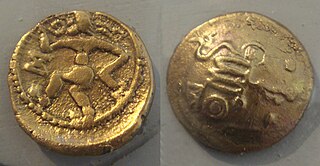
The Cocosates or Cocosates Sexsignani were an Aquitani tribe dwelling in present-day Landes during the Iron Age.

The Cocosates or Cocosates Sexsignani were an Aquitani tribe dwelling in present-day Landes during the Iron Age.
They are mentioned as Cocosates by Caesar (mid-1st c. BC), [1] and as Cocosates Sexsignani by Pliny (1st c. AD). [2] [3]
The etymology of the name remains obscure. It can be derived from the Gaulish stem cocos- ('scarlet red') attached to the suffix -ates ('belonging to'). Red is a colour commonly used in personal names (Cocus, Cocca, Cocidius, etc.) and associated with warfare. [4] [3]
The Cocosates lived in present-day Landes. Their territory was located east of the Atlantic Ocean, west of the Oscidates and Sotiates, north of the Tarbelli and Tarusates, and south of the Boii. [5]
Their chief town was known as Caequosa (modern Sescouze, near Castets). [6]
The Cocosates were a confederation of six tribes. They were probably clients of the neighbouring Tarbelli. [6]

The Petrocorii were a Gallic tribe dwelling in the present-day Périgord region, between the Dordogne and Vézère rivers, during the Iron Age and the Roman period.
The Nantuates or Nantuatae were a Gallic tribe dwelling around present-day Massongex, in the modern Canton of Valais (Switzerland) and adjacent areas of France, during the Iron Age and the Roman period.

The Redones or Riedones were a Gallic tribe dwelling in the eastern part of the Brittany peninsula during the Iron age and subsequent Roman conquest of Gaul. Their capital was at Condate, the site of modern day Rennes.

The Bituriges Vivisci were a Gallic tribe dwelling near modern-day Bordeaux during the Roman period. They had a homonym tribe, the Bituriges Cubi in the Berry region, which could indicate a common origin, although there is no direct of evidence of this.
The Caturiges were a Gallic tribe dwelling in the upper Durance valley, around present-day towns of Chorges and Embrun, during the Iron Age and the Roman period.

The Namnetes were a Gallic tribe dwelling near the modern city of Nantes during the Iron Age and the Roman period.

The Elusates were an Aquitani tribe dwelling in the modern Gers department, around present-day Eauze, France during the Iron Age and the Roman period.

The Tarbelli were an Aquitani tribe dwelling in the present-day regions of Labourd and Chalosse, in the west of Aquitania, during the Iron Age.

The Sotiates were a Gallic-Aquitani tribe dwelling in the region surrounding the modern town of Sos (Lot-et-Garonne) during the Iron Age and the Roman period.

The Auscii or Ausci were an Aquitani tribe dwelling around present-day Auch during the Iron Age.

The Bigerriones or Begerri were an Aquitani tribe dwelling in present-day Bigorre during the Iron Age.

The Nitiobroges were a Gallic tribe dwelling on the middle Garonne river, around their chief town Aginnon, during Iron Age and the Roman period.
The Acitavones were a small Gallic tribe dwelling in the Alps during the Iron Age.
The Adanates or Edenates were a small Gallic tribe dwelling around present-day Seyne, in the Alpes Cottiae, during the Iron Age.
The Ambisontes were a Gallic tribe dwelling in the upper Salzach valley during the Roman period.
The Quariates or Quadiates were a Gallic tribe dwelling in the valley of Queyras, in the Alps, during the Iron Age.
The Vennones or Vennonetes were a Rhaetian tribe dwelling in the northern Alps, between Chur and Lake Constance, during the Iron Age and the Roman era.
The Vergunni were a Gallic tribe dwelling in the valley of the Riou, near the Verdon river, during the Iron Age.
The Brigianii were a Gallic tribe dwelling around present-day Briançon during the Iron Age and the Roman period.
The Anatilii were a Gallic tribe dwelling in the Alpilles region during the Iron Age.